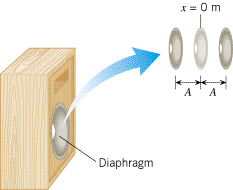The diaphragm of a loudspeaker moves back and forth in simple harmonic motion to create sound, as in Figure 10.12. The frequency of the motion is f![]() =
=![]() 1.0 kHz and the amplitude is A
1.0 kHz and the amplitude is A![]() =
=![]() 0.20 mm. (a) What is the maximum speed of the diaphragm? (b) Where in the motion does this maximum speed occur?
0.20 mm. (a) What is the maximum speed of the diaphragm? (b) Where in the motion does this maximum speed occur?
 |
|
Reasoning
The maximum speed vmax of an object vibrating in simple harmonic motion is vmax![]() =
=![]() Aw (w in rad/s), according to Equation 10.8. The angular frequency w is related to the frequency f by w
Aw (w in rad/s), according to Equation 10.8. The angular frequency w is related to the frequency f by w![]() =
=![]() 2pf, according to Equation 10.6.
2pf, according to Equation 10.6.
Solution
